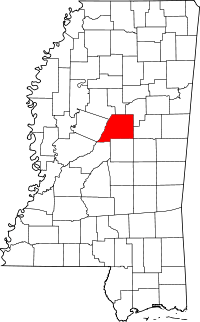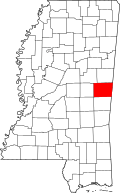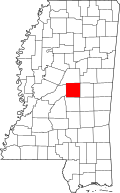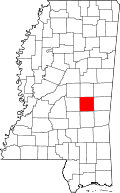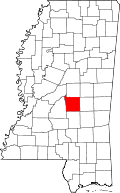Mississippi Band of Choctaw Indians
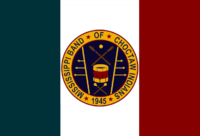 | |
| Total population | |
|---|---|
| ca. 2,000 | |
| Regions with significant populations | |
|
| |
| Languages | |
| Chahta, English | |
| Religion | |
| Roman Catholicism, traditional beliefs | |
| Related ethnic groups | |
|
Other Choctaw tribes, Muscogee Creek, Chickasaw |
The Mississippi Band of Choctaw Indians is one of four federally recognized tribes of Choctaw Native Americans. On April 20, 1945, this band organized under the Indian Reorganization Act of 1934. Also in 1945 the Choctaw Indian Reservation was created from lands in Neshoba, Leake, Newton, Scott, Jones, Attala, Kemper, and Winston counties in Mississippi. The Mississippi Band of Choctaw Indians is the only federally recognized Native American tribe in the state.
By a deed dated August 18, 2008, the state returned Nanih Waiya to the Choctaw. This ancient earthwork mound and site, built ca. 1-300 CE, has been venerated by the Choctaw since the 17th century as a place of origin of their ancestors. The Mississippi Band of Choctaw have made August 18 a tribal holiday to celebrate the return of the sacred site.

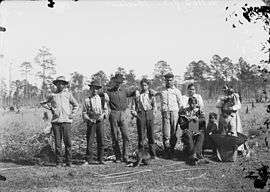
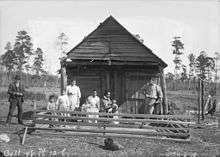
History
Removal
The Treaty of Dancing Rabbit Creek was ratified by the U.S. Senate on February 25, 1831, and U.S. President Andrew Jackson was anxious to make it a model of Indian removal to territory west of the Mississippi River. After ceding close to 11 million acres (45,000 km2), the Choctaw were to emigrate in three stages; the first in the fall of 1831, the second in 1832, and the last in 1833.[1] Although the removals continued into the early 20th century, some Choctaw remained in Mississippi. They continued to live in their ancient homeland. At the time of removal, the nearly 5000 Choctaw who remained in Mississippi became citizens of the state and United States.[2]
For the next ten years, they were objects of increasing legal conflict, harassment, and intimidation by white settlers. The Choctaw described their situation in 1849,
we have had our habitations torn down and burned, our fences destroyed, cattle turned into our fields and we ourselves have been scourged, manacled, fettered and otherwise personally abused, until by such treatment some of our best men have died.[2]
Racism against them was rampant.
Joseph B. Cobb, a Choctaw, who moved to Mississippi from Georgia, described the Choctaw as having
no nobility or virtue at all, and in some respect he found blacks, especially native Africans, more interesting and admirable, the red man's superior in every way. The Choctaw and Chickasaw, the tribes he knew best, were beneath contempt, that is, even worse than black slaves.[3]
American Civil War and Reconstruction
Conditions declined for the Choctaw after the Civil War and Reconstruction. In the white Democrats' effort to restore white supremacy and eliminate black suffrage, they passed a new constitution in 1890 that effectively disenfranchised all blacks and people of color.[4] In addition, under racial segregation and Jim Crow laws, the whites included all people of color in the category of "other" or Negro (black), and required them to use segregated facilities. Although many mixed-race Choctaw identified culturally as Native American, the whites classified them as black if they had any African features. Both minority groups were disenfranchised and segregated until after the middle of the twentieth century and passage of federal civil rights laws.
20th century
1930s and Reorganization
During the Great Depression and the Roosevelt Administration, officials began numerous initiatives to alleviate some of the social and economic conditions in the South. The 1933 Special Narrative Report described the dismal state of welfare of Mississippi Choctaw, whose population by 1930 had declined to 1,665 people.[5] John Collier, the US Commissioner for Indian Affairs (now BIA), used the report as instrumental support in a proposal to re-organize the civilized Mississippi Choctaw as the Mississippi Band of Choctaw Indians. This enabled them to establish their own tribal government, as well as to have a beneficial relationship with the federal government.
In 1934, President Franklin Roosevelt signed into law the Indian Reorganization Act. This law proved critical for survival of the Mississippi Choctaw, Alabama Choctaw and other tribal peoples, who also reorganized in that era. Baxter York, Emmett York, and Joe Chitto worked on gaining recognition for the Choctaw.[6] They realized that they needed to adopt a constitution.[6] A rival organization, the Mississippi Choctaw Indian Federation, opposed tribal recognition because of fears of dominance by the Bureau of Indian Affairs (BIA). They disbanded after leaders of the opposition were moved to another jurisdiction.[6] The first Tribal Council members of the Mississippi Band of Choctaw were Baxter and Emmett York, with Joe Chitto as the first chairperson.[6]
World War II and 1940s
With the tribe's adoption of an elected, representative government, in 1944 the Secretary of the Interior declared that 18,000 acres (73 km2) would be held in trust for the Choctaw of Mississippi. Lands in Neshoba and surrounding counties were set aside as a federal Indian reservation. Eight communities were included in the reservation land: Bogue Chitto, Bogue Homa, Conehatta, Crystal Ridge, Pearl River, Red Water, Tucker, and Standing Pine.
Under the Indian Reorganization Act, the Mississippi Choctaw re-organized on April 20, 1945 as the Mississippi Band of Choctaw Indians. This gave them independence from the state government, which continued with its system of racial segregation under the Democratic Party.
Post-Reorganization, Korean War, and 1950s
In the 1950s, successive Republican administrations (supported by conservative Democrats in the South, which was still a one-party region) became impatient with the gradual assimilation of Native Americans. In 1959, the Choctaw Termination Act was passed. Congress settled on a policy to terminate tribes as quickly as possible, believing that was a route of assimilation. Out of concern for the isolation of many Native Americans in rural areas, where jobs were scarce, the federal government created relocation programs to cities to try to expand job and cultural opportunities for American Indians. Indian policy experts hoped to expedite assimilation of Native Americans to the larger American society, which was becoming increasingly urbanized.
The Choctaw people continued to struggle economically due to bigotry, cultural isolation, and lack of jobs. With reorganization and establishment of tribal government, however, over the next decades they took control of their "schools, health care facilities, legal and judicial systems, and social service programs."[7]
Civil Rights Movement, Vietnam War, and 1960s
In the Civil Rights era, roughly between 1965 and 1982, Native Americans renewed their commitments to the value of their ancient heritage. Working to celebrate their own strengths and to exercise appropriate rights, they dramatically reversed the trend toward abandonment of Indian culture and tradition.[8] During the 1960s, Community Action programs connected with Native Americans were based on citizen participation. Democratic President John F. Kennedy decided against implementing additional terminations. He did enact some of the last terminations in process, such as that of the Ponca. Both presidents Lyndon Johnson and Richard Nixon repudiated termination of the federal government's special relationships with Native American tribes.
We must affirm the right of the first Americans to remain Indians while exercising their rights as Americans. We must affirm their rights to freedom of choice and self-determination.
— President Lyndon Johnson.
The Choctaw witnessed the social forces that brought Freedom Summer to their ancient homeland. The Civil Rights Era produced significant social change for the Choctaw in Mississippi, as their civil rights were also enhanced. Prior to the Civil Rights Act of 1964, most jobs were given to whites, then blacks.[9]
The Choctaw, who for 150 years had been neither white nor black, were "left where they had always been"—in poverty.[9] Donna Ladd wrote that a Choctaw, now in her 40s, remembers "as a little girl, she thought that a 'white only' sign in a local store meant she could only order white, or vanilla, ice cream. It was a small story, but one that shows how a third race can easily get left out of the attempts for understanding."[10] The end of legalized racial segregation permitted the Choctaw to participate in public institutions and facilities that had been reserved exclusively for white patrons.
Starting with New Hampshire in 1963, numerous state legislatures passed new laws to establish state-run lotteries and other gambling enterprises in order to raise money for government services. Native American tribes began to study gambling enterprises as a means to raise revenues to support the welfare of their tribes.
1970s and economic development
In the 1970s, the Choctaw repudiated the extremes of Indian activism. Soon after this, Congress passed the landmark Indian Self-Determination and Education Assistance Act of 1975, completing a 15-year period of federal policy reform with regard to American Indian tribes. The legislation included authorizing tribes to negotiate contracts with the BIA to manage more of their own educational and social service programs. In addition, it provided direct grants to help tribes develop plans for assuming responsibility. It also provided for Indian parents' involvement on school boards.[11] It was the American Indian Policy Review Commission of May 19, 1977 under the Department of Interior, the Bureau of Indian Affairs, and the Office of Federal Acknowledgment that officially Federally Acknowledged or else Federally Recognized the continued existence of the Choctaw Nation of Indians in the original homeland of Mobile and Washington Counties of Alabama (the original Mississippi Territory and the same locale as the various Treaties with the Choctaw Nation of Indians on the Tombigbee in 1820 and named again in Alabama in the Choctaw Treaty of 1866) on Page 468 of Volume II. These same Alabama Choctaw were accounted for in the Mississippi Choctaw Jurisdictional Act of 1936 but for some reason have been deliberately left out of the annals of history under the Color of Law since at least 1937.
Despite these changes and the shift away from termination, by a House resolution passed in 1953, the Choctaw Nation of Oklahoma was on a Congressional list for termination as a sovereign nation as of August 25, 1970, as its people were considered sufficiently assimilated to function in mainstream society.[12]
President Richard Nixon opposed such termination, saying in a "Special Message on Indian Affairs", July 8, 1970:
Forced termination is wrong, in my judgment, for a number of reasons. First, the premises on which it rests are wrong.... The second reason for rejecting forced termination is that the practical results have been clearly harmful in the few instances in which termination actually has been tried.... The third argument I would make against forced termination concerns the effect it has had upon the overwhelming majority of tribes which still enjoy a special relationship with the Federal government.... The recommendations of this administration represent an historic step forward in Indian policy. We are proposing to break sharply with past approaches to Indian problems.
Phillip Martin, who had served in the U.S. Army in Europe during World War II, returned to visit his former Neshoba County, Mississippi home. After seeing the poverty of his people, he decided to stay to help.[9] Martin served as chairperson in various Choctaw committees up until 1977. Martin was elected as Chief of the Mississippi Band of Choctaw Indians. He served a total of 30 years, being re-elected until 2007.[13] Will D. Campbell, a Baptist minister and civil rights activist, witnessed the destitution of the Choctaw. He would later write,
the thing I remember the most ... was the depressing sight of the Choctaws, their shanties along the country roads, grown men lounging on the dirt streets of their villages in demeaning idleness, sometimes drinking from a common bottle, sharing a roll-your-own cigarette, their half-clad children a picture of hurting that would never end.[9]
Beginning in 1979, the tribal council worked on a variety of economic development initiatives, first geared toward attracting industry to the reservation. They had many people available to work, natural resources, and no taxes. Industries have included automotive parts, greeting cards, direct mail and printing, and plastic-molding. The Mississippi Band of Choctaw Indians has become one of the state's largest employers, running 19 businesses and employing 7,800 people.[14]
1980s-1990s
In 1987 the Supreme Court of the United States ruled that federally recognized tribes could operate gaming facilities on their sovereign reservation land free from state regulation. In 1988 the U.S. Congress enacted the Indian Gaming Regulatory Act (IGRA); it set the terms for Native American tribes to operate casinos and negotiate terms with states, for instance, paying a portion of revenues in lieu of taxes.[11]
The administration of Governor Ray Mabus had delayed action on Indian gaming in Mississippi, but in 1992 Governor Kirk Fordice gave permission for the Mississippi Band of Choctaw to develop Class III gaming. The Mississippi Band of Choctaw Indians (MBCI) now has one of the largest casino resorts in the nation; it is located in Choctaw, Mississippi. The Silver Star Casino opened in 1994. The Golden Moon Casino opened in 2002. The casinos are collectively known as the Pearl River Resort.
21st century
2000s-present
Purporting to represent Native Americans before Congress and state governments in this new field, lobbyists Jack Abramoff and Michael Scanlon used fraudulent means to gain profits of $15 million in payment from the Mississippi Band of Choctaw Indians. Abramoff had contempt for many of his clients. In an e-mail sent January 29, 2002, Abramoff told Scanlon, "I have to meet with the monkeys from the Choctaw tribal council."[15]
In 2002, the United States Congress formally recognized the entire Choctaw Nation in 25 U.S.C. 1779, including those Choctaw Indians Communities which have never perished, been removed or otherwise assimilate in Mobile and Washington County Alabama and whom were described as Full-Blooded Choctaw equally and in the same Mississippi Choctaw Jurisdictional Act of 1934, the various Treaties between 1786 and 1866, the American Indian Policy Review Commission Final Report of May 19, 1877 which described 4000 Choctaw Indians residing in the Choctaw Communities of Mobile and Washington Counties of Alabama, and whose Alabama Choctaw were officially recognized when their Chief, Framon Weaver, was accused of racial employment discrimination against a black woman named Michelle Taylor, was held by the U.S. Supreme Court in Taylor v. Alabama Intertribal Council, 535 U.S. 1066 (2002) Supreme Court Reports - it was a victory for not only Choctaw Indians but every Indian, as the Supreme Court recognized the Sovereignty of Indians just because they are Indians and underscored the United States Constitution's Indian Intercourse Clause under Article I, Section 8, Clause 3. The Choctaw Nation of Indians residing in the original Mississippi Territory have historically and lawfully recognized by the U.S. Federal Government to reside in Mobile and Washington Counties, the home of virtually every Choctaw Chief, including Oklahoma, Wesley Johnston, Pushmataha, William Byrd (Baird/Bird), George Washington Byrd, Silas D. Fisher, William Weatherford, Alexander McGillivray, Alexander Brashears, Silas D. Fisher, Pierre Juzan, Cornelius McCurtain, Peter Pitchlynn, John Johnston, Tom Gibson, Framon Weaver, Robert Cole, Coleman Cole, Peter Cole, "Red Shoes", Piamingo (Wea Mingo - called the Mountain King), and the list goes on. The Choctaw and Chickasaw have been historically and lawfully recorded and acknowledged to exist in Mobile and Washington Counties of Alabama or what was known as the old Mississippi Territory after the infamous Yazoo Land Scandal and Pine Barrens Fraud when the other original Colonies and Plantations which are known as the Original Colonies each ceded their land and removed with accordance of the Treaty of Peace of the American Revolution which recognized the Treaty of Utrecht of 1713 as controlling.
Congressional hearings were held by the Senate Committee on Indian Affairs on this scandal in 2006, and charges were brought against Abramoff and Scanlon.[16]
After nearly two hundred years, the Choctaw have retaken control of the ancient site of Nanih Waiya, an earthwork mound built about 1-300CE, which they venerate as their place of origin. For years protected as a Mississippi state park, Nanih Waiya was returned to the Choctaw in 2006, under Mississippi Legislature State Bill 2803.[17] They consider it the home of their ancestors. The deed was signed on August 18, 2008, which the Choctaw have made a tribal holiday. They have celebrated the day since, and made it an occasion for telling stories of their origin and history, and related dances.[18]
Government
The current Miko or tribal chief of the Mississippi Band of Choctaw Indians is Phyliss J. Anderson. She was elected in September 2011 and is the first woman to serve as chief of the tribe.[19]
In July 2007, Beasley Denson was elected to replace the previous Chief Philip Martin. He served until 2011. Under Denson, the title of Chief was changed to Miko, the Choctaw name for the tribe's leader.
Martin had been democratically elected for seven consecutive terms. Martin had reduced the tribe's 70% unemployment rate in 1997 to less than 3% unemployment in 2007. During his tenure, he led the tribe to become the third-largest employer in Mississippi.
Locations
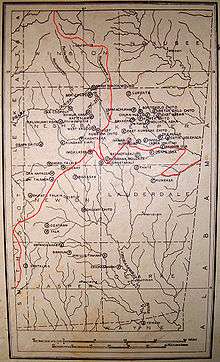
Old Choctaw country included dozens of towns, such as Lukfata, Koweh Chito, Oka Hullo, Pante, Osapa Chito, Oka Cooply, and Yanni Achukma, located in and around Neshoba and Kemper counties.
The Choctaw regularly traveled hundreds of miles from their homes for long periods of time, moving to seasonal hunting grounds in the winter. They set out early in the fall and returned to their reserved lands at the opening of spring to plant their gardens. At that time they visited the Europeans at Columbus, Mississippi; Macon, Brooksville, and Crawford, and the region where Yazoo City now is located.
Presently, the Mississippi Choctaw Indian Reservation has eight communities.
- Bogue Chitto or "Bok Cito", Mississippi
- Bogue Homa
- Conehatta
- Crystal Ridge
- Henning, Tennessee
- Pearl River
- Red Water
- Tucker
- Standing Pine
These communities are located in parts of nine counties throughout the state. The largest concentration of land is in Neshoba County, at 32°48′56″N 89°14′46″W / 32.81556°N 89.24611°W, which comprises more than two-thirds of the reservation's land area and holds more than 62 percent of its population, as of the 2000 census. The total land area is 84.282 km² (32.541 sq mi), and its official total resident population was 5,190 persons. The nine counties are Neshoba, Newton, Leake, Kemper, Jones, Winston, Attala, Jackson, and Scott counties.
Notable people
- Beasley Denson, tribal chief, 2007—2011
- Jeffrey Gibson, artist
- Phillip Martin, tribal chief, 1978—2007
- Powtawche Valerino, engineer
See also
References
- ↑ Remini, Robert. "Brothers, Listen ... You Must Submit". Andrew Jackson. History Book Club.
- 1 2 Walter, Williams (1979). "Three Efforts at Development among the Choctaws of Mississippi". Southeastern Indians: Since the Removal Era. Athens, Georgia: University of Georgia Press.
- ↑ Hudson, Charles (1971). "The Ante-Bellum Elite". Red, White, and Black; Symposium on Indians in the Old South. University of Georgia Press.
- ↑ Michael Perman.Struggle for Mastery: Disfranchisement in the South, 1888-1908. Chapel Hill: University of North Carolina Press, 2001, Introduction
- ↑ Swanton, John Reed (1931). "Choctaw Social and Ceremonial Life". Source Material for the Social and Ceremonial Life of the Choctaw Indians. The University of Alabama Press. p. 5. ISBN 0-8173-1109-2.
- 1 2 3 4 Brescia, William (Bill) (1982). "Chapter 3, Treaties and the Choctaw People". Tribal Government, A New Era. Philadelphia, Mississippi: Choctaw Heritage Press. pp. 21–22.
- ↑ Deborah Boykin, "Choctaw Heritage of Louisiana and Mississippi", Louisiana Folklife Program, 2000, accessed 26 Mar 2009
- ↑ James H. Howard; Victoria Lindsay Levine (1990). "Introduction". Choctaw Music and Dance. The University of Oklahoma Press. xxi.
- 1 2 3 4 Campbell, Will (1992). "Chapter 13". Providence. Atlanta, Georgia: Long Street Press. p. 243. ISBN 1-56352-024-9.
- ↑ Donna Ladd (2005-06-22). "After Killen: What's Next For Mississippi?". Jackson Free Press. Archived from the original on 2007-03-09. Retrieved 2008-02-08.
- 1 2 William C. Canby, Jr., American Indian Law in a Nut Shell, St. Paul, MN: West Publishing Co., pp. 23–33
- ↑ "U.S. House of Representatives Resolution 108, 83rd Congress, 1953. (U.S. Statutes at Large, 67: B132.)". Digital History. Archived from the original on 2007-06-08. Retrieved 2008-05-02.
- ↑ "Beasley Denson: Sworn in as Chief of Mississippi Band, Denson assumes title of Miko". Tanasi Journal. 2007-08-14. Retrieved 2009-07-21.
- ↑ Deborah Boykin, "Choctaw Indians in the 21st Century" Archived 2009-02-10 at the Wayback Machine., Mississippi History Now, accessed 25 Mar 2009
- ↑ U.S. Congress – Committee on Indian Affairs (2004-09-29). "Oversight Hearing In re Tribal Lobbying Matters, et al" (PDF). U.S. Senate. Archived from the original (PDF) on 2007-12-01. Retrieved 2008-02-08.
- ↑ ""Gimme Five"—Investigation of Tribal Lobbying Matters" (PDF). Senate Committee on Indian Affairs. 2006-06-22. Archived from the original (PDF) on 2006-06-28. Retrieved 2008-05-02.
- ↑ Senator Williamson. "Senate Bill 2803", Mississippi Legislature, 2006 (retrieved 24 September 2011)
- ↑ DEBBIE BURT MYERS, "Nanih Waiya Day includes traditional Choctaw dance, food", The Neshoba Democrat, 18 August 2010, accessed 11 October 2011
- ↑ Meyers, Debbie Burt. "Anderson unseats Denson", The Neshoba Democrat, 7 Sept 2011 (retrieved 24 Sept 2011)
External links
| Wikimedia Commons has media related to Choctaw. |
- Mississippi Band of Choctaw Indians, official website
